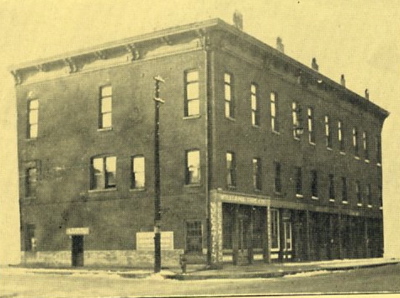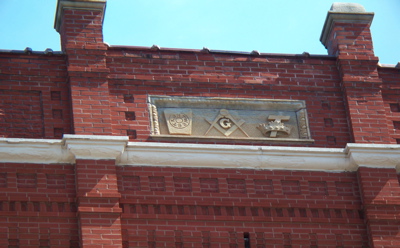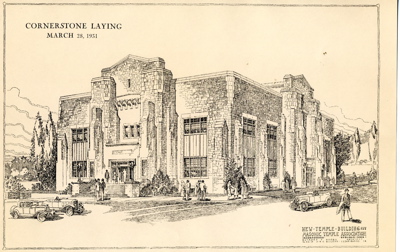Encyclopedia Dubuque
"Encyclopedia Dubuque is the online authority for all things Dubuque, written by the people who know the city best.”
Marshall Cohen—researcher and producer, CNN
Affiliated with the Local History Network of the State Historical Society of Iowa, and the Iowa Museum Association.
MASONIC TEMPLE
MASONIC TEMPLE. Home of the MASONIC LODGE in Dubuque.
In 1842 the newly organized Dubuque Lodge made their temporary quarters at the Shakespeare House (512 Main Street) across from the site of the present HOTEL JULIEN DUBUQUE (1) The organization then took up a more permanent location over the drug store of Timothy MASON and then moved to a new building erected by Emerson and Shields on the northwest corner of 4th and Main.
From 1870 to 1895 the Lodge met at the Freemason's Hall (formerly the Julien Theater) at 5th and Locust. Serious interest in constructing a temple was voiced in April 1890 when 30-day options were secured on three sites: the Goodrich property on the southwest corner of Sixth and Locust for $16,000, the Jackson property on the southwest corner of Ninth and Locust, and the Universalist property on the northeast corner of Main and 10th for $15,000. The five Masonic organizations had $5,500 on hand. The incorporation of a Masonic Building Association was authorized with a capitalization of $100,000. Shares cost $100 each with a dividend of fifty cents per month until the stock was paid in full. (2)
In 1894 John Vincent RIDER offered the third floor of a new building he was having constructed at 10th and Main STREETS on land which had been the site of the Universalist Church. The first two floors were to be occupied by the DUBUQUE CABINET MAKERS' ASSOCIATION. (3) The order accepted the offer and met from 1895 to 1906 on the third floor of the building used later as the offices of INTERSTATE POWER COMPANY. Masonic insignia were displayed near the top of the building.
From 1906 to 1932 the First Temple was located at 11th and Locust Street in a former Presbyterian church. (4) In 1930 an agreement was signed between the City of Dubuque and the organizations owning the Masonic Temple for the sale of the building to the CARNEGIE-STOUT PUBLIC LIBRARY. The agreed upon price was $22,500 with $2,500 or more paid on May 1, 1930 and November 1, 1930 and each succeeding year until the price had been reached. The lodge building separated from the library by an alley would be used for expansion with reading rooms and bookshelves. (5)
Interest in building a temple was first voiced in 1916, but uncertain conditions caused by WORLD WAR I and building restrictions led to the idea being postponed. Interest in building began again in 1921. With the sale of the building at 11th and Lucust being accomplished, building plans resumed.
By 1923 a building committee had been formed. On February 13, 1924 the announcement was made that the Masonic lodges of Dubuque had purchased the property on the southeast corner of Seventh and Locust STREETS for $50,000.
The old temple was demolished soon after the Masons moved to their present temple. Ironically the building sets on the same block as the official home of the archbishop. Although their is no documented proof of their responsibility, many of the Masons at that time may have been responsible for the fact that much of the stained glass from the old temple was moved to GRANDVIEW AVENUE UNITED METHODIST CHURCH. (6) Though the Masonic Order demanded belief in only a generalized "Great Architect of the Universe," the organization remained Protestant. Until a new code of canon law was signed by the Pope in 1983, a Catholic who joined a Masonic order was automatically excommunicated. (7)
The Masonic temple was dedicated on March 15, 1932 during a time when the nation was in the midst of the GREAT DEPRESSION at a cost of $325,000. The 4,200-square-foot ballroom in the current temple at 1155 Locust was the scene of minstrel shows in the 1930s and until the end of WORLD WAR II big bands featuring Sammy Kaye and Dorothy Lamour. The temple became a meeting hall for as many as fourteen Masonic groups. Among other rooms were a Ladies' Dressing Room, Men's Reading Room, and a pool room with six slate tables. In 1982 the stage, last used for a community event in 1964, was reopened with seating for up to 500. (8)
---
Source:
1. Fryxell, David, "Show Shines Light on a Masonic Temple," Telegraph Herald, August 4, 1893, p. 5
2. "For a Masonic Temple," Dubuque Daily Herald, April 1, 1890, p. 3
3. "Hunting a Home," Dubuque Daily Herald, March 13, 1894, p. 4. Online: https://news.google.com/newspapers?nid=_OG5zn83XeQC&dat=18940313&printsec=frontpage&hl=en
4. Fryxell
5. "City Purchases Masonic Temple," Telegraph-Herald and Times-Journal, February 6, 1930, p. 2
6. London, Michelle, "Ecumenical Stewards," Telegraph Herald, May 7, 2022, p. 7A
7. Fryxell
8. Ibid.






